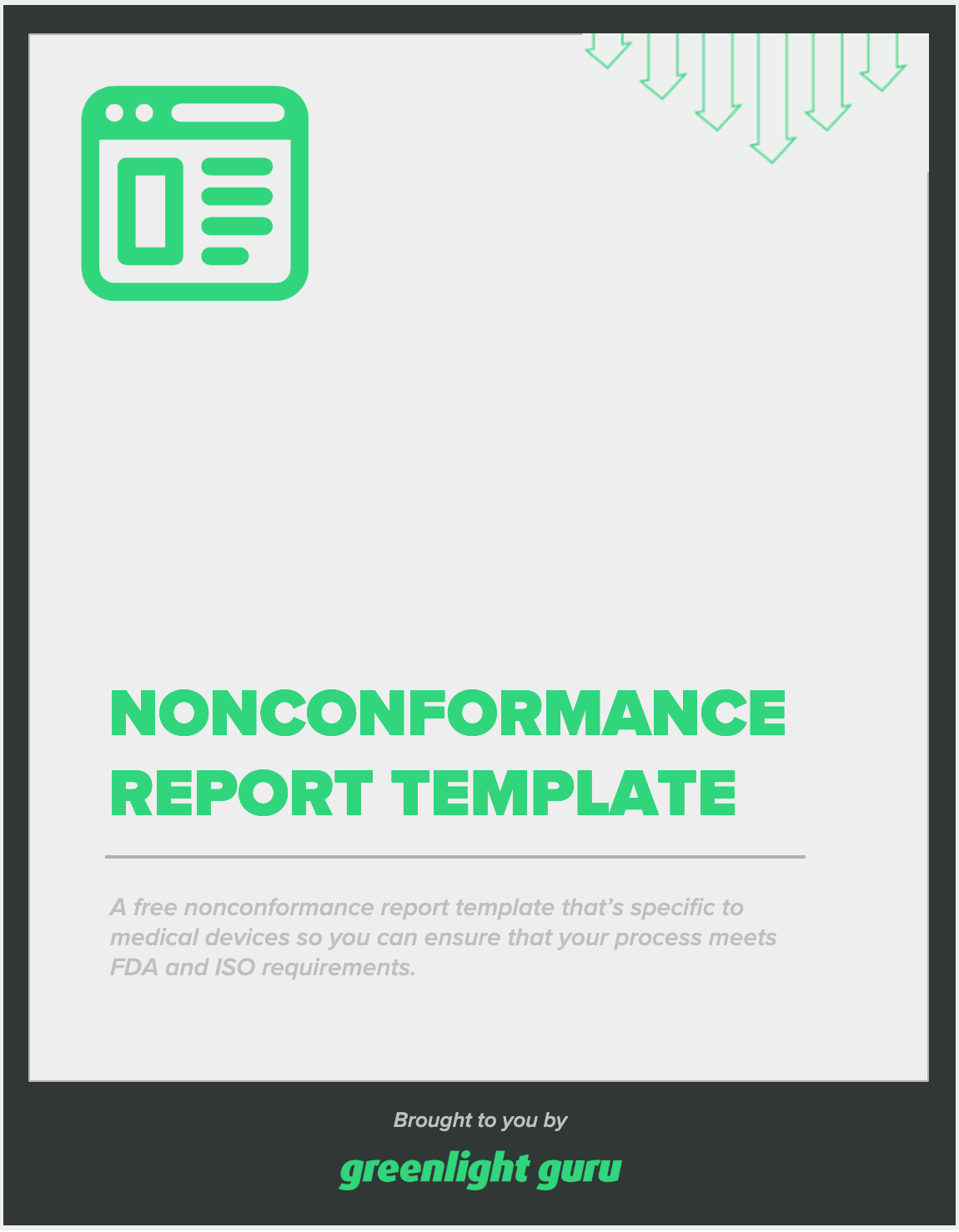How to Write a Nonconformance Report in 7 Steps

Nonconformance is a word no quality manager wants to hear.
Many quality managers dread nonconformances, wishing that they lived in a world with perfect processes that delivered perfect products. Unfortunately, that isn’t our world. That doesn’t mean, however, that a nonconformance is all bad.
In fact, a nonconformance can be considered both a risk and an opportunity.
The key to transforming a nonconformance into an opportunity is how well you can construct your nonconformance report.
What is a nonconformance report?
A nonconformance report (NCR) is a retrospective document used in the medical device industry to record instances where a product or process does not meet regulatory or internal quality requirements. Once a nonconformance is identified (whether during manufacturing, inspection, or post-market surveillance), a nonconformance report must be initiated to document the issue, investigate the root cause, and implement corrective actions.
How to write a nonconformance report in 7 simple steps
To write an effective nonconformance report, follow the seven step plan of action listed below, and then document your findings and the actions taken.
1. Control the nonconformance
The first step of the nonconformance report is to control the nonconformance.
This step needs to be taken immediately after a nonconforming product or process is identified. Nonconforming products can be identified at any stage of the production process.
The nonconformance could be a product that is about to ship or arrive at a customer.
In fact, in one of my previous manufacturing roles, I had to pull nonconforming products back to our facility that was in the process of being shipped to a customer.
I was only able to do so because my quality team on the production floor was able to quickly identify the nonconformance before the shipment arrived at the customer's facility. We ultimately avoided a potentially negative impact on end users of the nonconforming product.
A nonconformance may also be a part that is used in other assemblies. Identification of a product made with the nonconforming part can be challenging. It can also be costly to rework or scrap as more labor has been consumed in the assembly process.
Unless there is high confidence that the inspection process will detect every non-conforming part, any nonconforming processes should be shut down until a root cause of the nonconformance is identified and addressed. If products or parts are impacted, then these need to be controlled as nonconforming products.
The controlling action occurs any time new nonconforming products or incorrect quality control processes are identified and should not wait on a material review board (MRB) to convene, as this may be too late.
Typically, nonconforming products are controlled in a Quality Control Hold. On a production floor this may be a closed off area to hold the nonconforming product that is only accessible by the quality team. Having the nonconforming product or processes controlled gives you the time to properly assess the nonconformance and make the appropriate decisions.
2. Review the nonconformance
The second step is to review the nonconformance that was found.
One way to do this is to convene a material review board (MRB). Your company should determine the key players involved in this group prior to the occurrence of a nonconformance. MRB members are responsible for reviewing the nonconformance and determining next steps.
It’s important to note that one part of the review process involves controlling and segregating the nonconforming product, if not already completed. The last thing you want is for the problematic part to advance into manufacturing or a defective product to interface with end users.
FDA requirements for nonconforming product can be found in 21 CFR 820.90(a).
3. Determine disposition for nonconformity
After you review the nonconformance, you will need to identify the disposition actions needed to correct the nonconformity. “Disposition” is a term that covers whatever action you take for corrective measures.
Note that disposition might mean taking no action at all. According to FDA, “the regulation provides you with the flexibility to decide if an investigation is necessary or not.” If a nonconformance is the result of an already known process problem, you may choose not to initiate a separate investigation.
More likely, however, is that your nonconformity falls into one of the following five types of disposition categories:
-
Scrap: Used when you decide to destroy a product instead of use it.
-
Return to supplier: Used when the supplier ships the wrong component or piece and it must be returned. Some companies use the phrase “Return to Vendor” or “RTV” for short.
-
Downgrade: Used when a problem is found with a new version of a medical device following a change. Until a solution is identified, the previous version is to be used.
-
Use as is: Used when an unimportant defect is found with one of your products, such as a cosmetic flaw, and it’s determined that the product can still be used as intended.
-
Rework: Used when a product fails to meet certain stage requirements during quality assurance testing, but a correction can be made that still allows it to meet specifications after retesting. (Note that you must document said rework in your device history record (DHR).)
Even if you take minimal action, you must track all actions taken with regards to the nonconformance. If you find yourself scrapping more products than usual, for example, you may be on the trail of discovering a process nonconformance rather than a product nonconformance.
4. Perform root cause analysis on the nonconformance
The goal of root cause analysis is to find the primary cause of a nonconformance and determine whether further investigations (if any) are necessary.
The complexity of medical device manufacturing means there will likely be numerous possibilities for the cause of a nonconformance. Your goal isn’t to find any reason a nonconformance occurred but to find the reason.
Create a problem statement that encompasses all the information you can gather about the nonconformance, including actual impact and potential impact. Conduct the necessary research to uncover this data so you have objective evidence you can provide as needed.
After gathering the necessary data, you will then need to determine all of the factors that might have caused the nonconformance. As you investigate, include team members who were involved in the process leading up to the nonconformance, as well as any available experts who are knowledgeable about this type of nonconformance.
With that team assembled, you can use root cause investigative methodologies, such as failure modes and effects analysis (FMEA), fishbone diagram, five whys, or fault tree analysis.
Using one or a combination of these methodologies will lead you to determining the root cause. Be persistent. Keep peeling back layers until you’ve found the fundamental problem.
5. Take action to prevent the nonconformance
Minor actions specific to the root cause may be completed in the nonconformance. These may include retraining activities, clarifying work instructions, or refining non-conforming products to meet quality standards, for example.
In the case of a major non conformance that has a high criticality to product, impacts multiple processes, or has become a systemic trend, then further corrective action through a CAPA may be necessary. As FDA puts it, “Nonconformances are a gateway mechanism for CAPA.”
Any of the types of flaws we categorized in step two can be reason for initiating a CAPA investigation if enough of them recur.
Remember that CAPA is best used to prevent problems that have become systemic, high criticality, or otherwise ambiguous and overly complex. If your company is CAPA happy, you can create a burdensome amount of work.
For a more detailed look at the corrective and preventive action process, refer to our Ultimate Guide to CAPA for Medical Devices.
6. Monitor for effectiveness
Monitoring for effectiveness (if actions to correct root cause have been completed) may seem more passive than the other steps, but is no less important.
After taking actions to address the root cause of the nonconformance, you will need to monitor your processes and the products produced.
Ideally, the steps you took eliminated the problem, and the nonconformance doesn’t reappear after testing or upon a closer inspection.
If it does recur, it means your root cause determination was not accurate. In this case, you will need to go back to step three and dig deeper to determine if additional problems exist.
7. Document the nonconformance investigation
Documentation should be generated throughout all steps of this process. Your nonconformance report should include documentation showing completion of all steps of the nonconformance and include all relevant details and actions taken during the process.
Ensure that your nonconformance report guides whomever is reading—whether they be auditors or team members examining previous nonconformances— through your nonconformance management process. Review and approval should be completed as actions are taken and once the nonconformance is finalized.
Ensure compliance by leveraging nonconformance management software
Most nonconformance procedures tend to be reactive and defensive in nature. Quality managers likely recognize that a proactive, preventive approach would be better, but their processes are often stymied. Why? They’re working in a system that is working against them.
That’s where Greenlight Guru wants to help. As the leading cloud-based platform purpose-built for MedTech companies, our nonconformance management software empowers you to eliminate inefficiencies associated with quality event processes by removing excess documentation and automating your quality event processes.
With custom workflow templates created by you, incorporate specific, detailed steps following your company's protocol to automate the step-by-step process. Keep a single, up-to-date workflow with management controls in place for each of your nonconformance processes.
Ready to learn more? Contact us today for your free personalized demo of Greenlight Guru →
Etienne Nichols is the Head of Industry Insights & Education at Greenlight Guru. As a Mechanical Engineer and Medical Device Guru, he specializes in simplifying complex ideas, teaching system integration, and connecting industry leaders. While hosting the Global Medical Device Podcast, Etienne has led over 200...
Related Posts
Nonconformance (NC) and CAPA: When Should You Use Each Process?
Building an Effective CAPA Program: Key Steps and Common Challenges
5 Foundational Steps of a CAPA Quality Process
Get your free resource
7 Steps for Writing a Nonconformance Report











